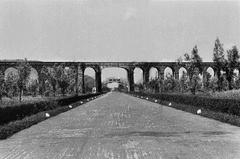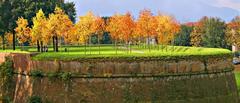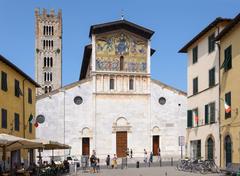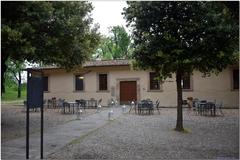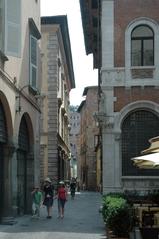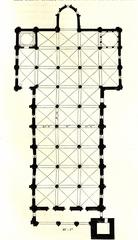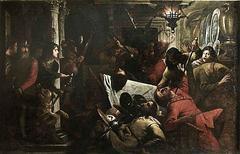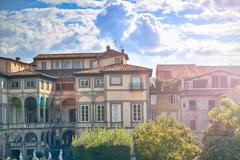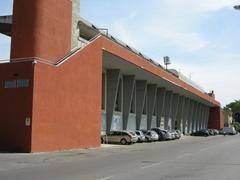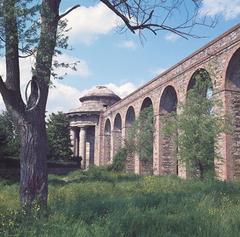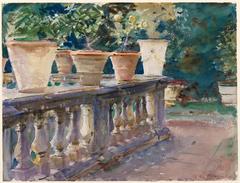Visiting San Michele in Foro: History, Tickets, and Tips
Date: 18/07/2024
Introduction
San Michele in Foro, nestled in the heart of Lucca, Italy, is a quintessential example of Romanesque architecture and stands as a monument to the city’s rich historical and cultural heritage. This guide aims to provide an in-depth exploration of San Michele in Foro, covering its storied past, architectural significance, practical visitor information, and tips for making the most of your visit. The basilica’s history dates back to the 8th century when it was constructed on the site of the ancient Roman forum. Over the centuries, it has evolved architecturally and artistically, reflecting the various cultural influences that have shaped Lucca. Today, San Michele in Foro is not just a relic of the past but a vibrant part of modern-day Lucca, attracting tourists, pilgrims, and art enthusiasts from around the world. For more detailed historical context, you can refer to the official Lucca tourism website.
Table of Contents
- Introduction
- A Legacy Etched in Stone - Unveiling the History of San Michele in Foro
- Visitor Information - Tickets, Hours, and Accessibility
- Travel Tips - Making the Most of Your Visit
- Nearby Attractions - Exploring Lucca’s Historical Sites
- Through the Ages - Transformations and Restorations
- A Living Legacy - San Michele in Foro Today
- FAQ
- Conclusion
A Legacy Etched in Stone - Unveiling the History of San Michele in Foro
Early Beginnings - From Roman Forum to Place of Worship
The basilica’s location speaks volumes about its ancient roots. It stands where the Roman forum of Lucca once thrived, forming the heart of the city’s civic and social life. As Christianity took root around the 8th century, a church dedicated to the Archangel Michael was erected, marking the beginning of San Michele in Foro’s long spiritual journey.
The Romanesque Era - A Flourishing of Architecture and Art
The 12th century ushered in a period of immense growth and prosperity for Lucca. This economic boom found expression in a wave of architectural projects, and San Michele in Foro was not left behind. The church, as seen today, largely reflects this era’s distinctive Romanesque style. Master craftsmen meticulously rebuilt the church, using local limestone that gives Lucca its unique charm. The façade, a masterpiece of Romanesque architecture, became the defining feature of San Michele in Foro.
The Enigmatic Facade - A Symphony of Symbolism and Beauty
The façade of San Michele in Foro is not just a visual delight but a complex narrative etched in stone. Its tiered design, rising upwards like a grand staircase to heaven, is typical of the Romanesque style. Four levels of exquisite columns, each different in design, create a sense of dynamic movement. Adorning these levels are sculptures of biblical figures, mythical creatures, and intricate decorative motifs. A majestic statue of the Archangel Michael, standing triumphant at the top, symbolizes protection and divine power.
Interior Treasures - A Glimpse into Lucca’s Artistic Heritage
While the façade captivates with its grandeur, the interior of San Michele in Foro holds artistic treasures. Visitors are greeted by a sense of tranquility and awe. The basilica’s spacious nave, flanked by aisles, leads to an elevated presbytery, showcasing the classic Romanesque layout. Among the highlights is the 14th-century marble altarpiece by Andrea della Robbia, depicting the Madonna and Child flanked by saints. Another notable treasure is the venerated Volto Santo di Lucca, a wooden crucifix said to have been miraculously carved.
Visitor Information - Tickets, Hours, and Accessibility
To fully enjoy your visit to San Michele in Foro, here’s some essential visitor information:
- Visiting Hours: The basilica is generally open from 9:00 AM to 6:00 PM, but hours may vary on holidays and special occasions.
- Tickets: Entrance to the basilica is typically free, but donations are appreciated. Special exhibitions or guided tours may require a ticket.
- Accessibility: The basilica is accessible to visitors with mobility issues, though some areas may present challenges. It’s advisable to contact the basilica in advance for specific accessibility needs.
Travel Tips - Making the Most of Your Visit
- Guided Tours: Consider joining a guided tour to gain deeper insights into the history and art of San Michele in Foro.
- Local Events: Check the local event calendar as the piazza often hosts markets, concerts, and cultural celebrations.
- Photography: While photography is allowed, please be respectful of ongoing services and other visitors.
Nearby Attractions - Exploring Lucca’s Historical Sites
San Michele in Foro is just one of many historical sites in Lucca. Other nearby attractions include:
- Lucca Cathedral: Another gem of Romanesque architecture, just a short walk away.
- Torre delle Ore: Climb this historic clock tower for stunning views of the city.
- Piazza dell’Anfiteatro: A unique oval-shaped piazza built on the ruins of an ancient Roman amphitheater.
Through the Ages - Transformations and Restorations
San Michele in Foro has undergone several transformations and restorations throughout the centuries. The 16th century saw the addition of the Renaissance-style Cappella del Santuario, while the 19th century witnessed significant restoration efforts aimed at preserving the basilica’s architectural integrity. These interventions have contributed to the layered history of San Michele in Foro.
A Living Legacy - San Michele in Foro Today
San Michele in Foro is not merely a relic of the past but a vibrant part of Lucca’s present. The piazza outside, once the Roman forum, continues to be a hub of activity, hosting markets, concerts, and celebrations. The basilica remains a place of worship, its bells marking the rhythm of daily life for the locals. Visitors can marvel at architectural grandeur, delve into artistic expressions, and experience the enduring spirit of Lucca.
FAQ
Q: What are the visiting hours for San Michele in Foro? A: The basilica is generally open from 9:00 AM to 6:00 PM, but hours may vary on holidays and special occasions.
Q: Is there an entrance fee for San Michele in Foro? A: Entrance to the basilica is typically free, but donations are appreciated. Special exhibitions or guided tours may require a ticket.
Q: Is San Michele in Foro accessible to visitors with mobility issues? A: Yes, the basilica is accessible to visitors with mobility issues, though some areas may present challenges. It’s advisable to contact the basilica in advance for specific accessibility needs.
Conclusion
San Michele in Foro stands as a beacon of Lucca’s historical and cultural heritage. Whether you’re an art lover, history enthusiast, or a curious traveler, this basilica offers a unique glimpse into the past. Plan your visit, explore its treasures, and immerse yourself in the timeless beauty of one of Lucca’s most cherished landmarks. For more information on visiting San Michele in Foro and other historical sites in Lucca, download our mobile app Audiala, check out our related posts, or follow us on social media for the latest updates and tips. Additional information can be found on the official Lucca tourism website.
References
- Visiting San Michele in Foro - History, Tickets, and Tips for Exploring Lucca’s Historical Gem, 2024, Official Lucca Tourism Website
- Exploring San Michele in Foro - Architectural Significance, Visiting Hours, and Tickets in Lucca, 2024, Official Lucca Tourism Website
